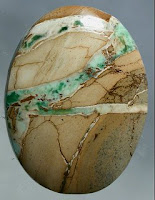Variscite is a hydrated aluminium phosphate mineral. It was at one time considered to be a relatively rare phosphate mineral. Because most Veriscite comes from close bye or the same location, it is sometimes confused with Turquoise; however, Variscite is usually much greener in color. Variscite is a secondary mineral formed by direct deposition from phosphate-bearing water that has reacted with aluminium-rich rocks in a near-surface environment. It occurs as fine-grained masses in nodules, cavity fillings, and crusts. Variscite often contains white veins of the calcium aluminium phosphate mineral Crandallite.
..
Variscite is sometimes used as a semi-precious stone, and is popular for carvings and ornamental use. It was first described in 1837 and named for the locality of Variscia, in Germany, the historical name of Vogtland. In 1894 Variscite was found near Fairfield, Utah, and given the name Utahlite. Later in the early 1900s Variscite was found in Nevada. Variscite is known for its bright to dark green coloration. The Navada Veriscite is also known for it black spider web colorations within the material.
Variscite is sometimes used as a semi-precious stone, and is popular for carvings and ornamental use. It was first described in 1837 and named for the locality of Variscia, in Germany, the historical name of Vogtland. In 1894 Variscite was found near Fairfield, Utah, and given the name Utahlite. Later in the early 1900s Variscite was found in Nevada. Variscite is known for its bright to dark green coloration. The Navada Veriscite is also known for it black spider web colorations within the material.
Fine carving and pendants have been made from the beginning out of the green Variscite. Pendants can be almost entirely the green Variscite or they can have streaks of the Variscite running through the host stone, similar to Boulder Opal and Boulder Turquoise, thus why sometimes the confusion.
A surprise to many, an unusual red variety of variscite occurs in certain Precambrian iron ores in the Middleback Ranges of South Australia. As with many gem and mineral findings in Australia, and in this Iron Monarch deposit, apatite in the hematite ores oxidized, leading to the formation of a large suite of secondary phosphates. Among these occurs variscite, which forms crystalline coatings on hematite surfaces, rarely associated with other phosphate minerals. The variscite contains approximately 10 percent iron. Amazingly the variscite from the Iron Monarch quarry is deep rose-red and transparent. It occurs in globular surface coatings consisting of small blocky crystals. Because of the black matrix and the transparency of the crystals, their overall appearance is dark cherry-red. Deposits of this same Red Veriscite material have now been found in Brazil and and pink variety in the Wood Mine, Cocke County, Tennessee.
Larger deposits of the Australian Red Veriscite allow for the formation of nice sized rocks that when cut, make for a beautiful Red Veriscite cabochon or pendant.
..
..
.
This Red Veriscite must not be confused with the Red River Jasper which also comes from Australia.

Also definitely don't confuse Veriscite with colored Sea Sediment Jasper from Indonesia.







